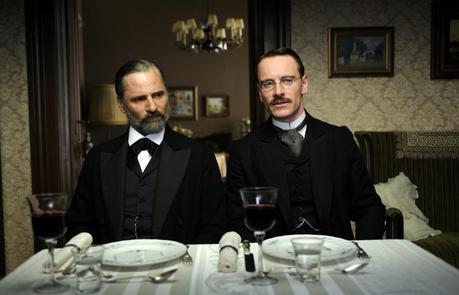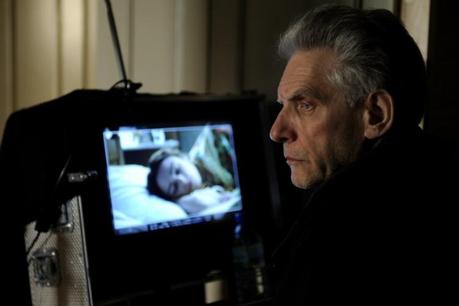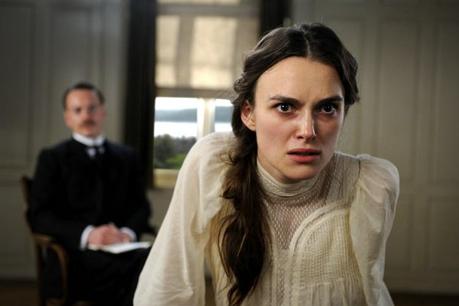Intricately layered and hypnotically complex, David Cronenberg’s brilliant adaptation of Christopher Hampton’s stage play “The Talking Cure” (in turn based on John Kerr’s book “A Most Dangerous Method”) takes on the deep-rooted neuroses associated with want, lust, and desire as exemplified by the destructive and symbiotic relationship between Sigmund Freud (Viggo Mortenson), Carl Jung (Michael Fassbender), and Sabina Spielrein (Keira Knightley). Eschewing almost every trace of the “body horror” that defined his formative work, and even the radical violence that punctuated his last two films, here Cronenberg burrows into the hidden recesses of psyches and intellects in torment and crafts a piece that explores his interests in indulgence and transformation in greater detail than almost anything he’s done. It feels like Cronenberg’s been working towards this film his entire career: it isn’t hard to trace the trajectory from the repression-gnawing parasites of “Shivers” to Jung’s embrace of his most primal sexual instincts in A Dangerous Method. Both involve violence and arousal as by-products of the grotesque (or the unexpressed); that Cronenberg is here dealing with something close to an accounted actuality rather than horrific fantasy makes the thematics presented all the more shattering when ultimately realized. There are consequences to pleasure, emotional and potentially deadening.
Opening on a hysterical, near-epileptic Spielrein being carted up to a sanatorium, Cronenberg immediately establishes the fractured, frightening tone of the film. Spielrein’s condition is violent and halting, causing her to stutter and contort herself. Given over to the psychiatric care of Jung, he decides to implement Freud’s radical “talking cure,” a theory that laid out the groundwork for all of modern psychoanalysis. By removing himself both visually and emotionally, Jung gets to the heart of Spielrein’s psychosis– her early and continued sexual excitement arising from her father’s disciplinary beatings years before. Two years later, cured, Spielrein begins medical studies herself, hoping to become a psychiatrist as well. Jung’s successful treatment of Spielrein grants him an audience with the much admired Sigmund Freud, and the two form an antagonistic bond that ultimately tests the beliefs of both men as well as the strength of their individual theories of psychoanalysis. Freud’s approach is clinical and rooted in sexuality; Jung opens himself up to the possibility of mysticism and parapsychology, to Freud’s growing distaste. When Spielrein confesses a sexual attraction to Jung the idea of it gnaws away at him and he reluctantly acts on it; from there Cronenberg’s film becomes a cavernous parade of defeat, humiliation (both sexual and professional) and self-doubt as Jung, Spielrein, and Freud commence an odyssey of interaction that spans years.

The principal actors all turn in exemplary performances here. Fassbender caps off a stellar year with a portrayal of Jung as a man haunted by the realization of his own desires and his crippling fear of acting on them. Watching his restraint erode away as he desperately tries to keep it in check, and its resultant effect on him, is mesmerizing. Mortenson is all cool, clinical detachment as Freud, playing up the Master’s need to exert authority as well his subtly condescending ridicule of any psychological theory not beholden to his own. And Knightley is simply stunning in her depiction of Spielrein, bringing her from the brink of madness to the composed manipulator she becomes at the end of the film (I would be surprised if she didn’t receive an Academy nod.) The three entwine themselves beautifully, like an intellectual threeway where the only rule is climax denial.
The deterioration of Freud and Jung’s intensely competitive and adversarial relationship allows for an illustration of differing psychological approaches that highlight several of Cronenberg’s authorial themes. The film’s lush evocation of myriad sexualities, and Jung’s growing awareness of his own ravenous sexual appetite, references previous Cronenberg works like Crash (where the outre’ fetish begins to have a strange and hypnotic allure to the film’s protagonist); the exploration of sadistic and masochistic tendencies in relationships recalls Videodrome‘s strange Samurai Dreams programs found inbetwixt the white noise of late night television reception. Cronenberg’s subtle treatment of the idea of transformation comes into play in A Dangerous Method as well, with Jung’s shifting ideological alliances and growing personal awareness acting as a less visceral mirror to Seth Brundle’s grotesque reawakening in The Fly. Cronenberg’s world is packed with the bizarre; here it’s just dressed more politely. Spielrein’s initial fits are nothing if not agonized representations of the consequences of repression. So too Jung’s state at the end of the film, hollowed and carved out, dreaming of the apocalypse and wondering how it all spiraled out of control, another major concern in this work.

Cronenberg filming A Dangerous Method
Control is constantly switching hands, especially between Spielrein and Jung: when she comes to him asking to begin a sexual relationship, Jung has the power to grant or deny her wish. When he in turn becomes infatuated, the power reverts. Jung weeping into her skirts, begging her to stay, is perhaps the film’s most openly vulnerable moment; Jung never allows himself this concession to emotion again. Spielrein later seeks to inflame and dominate Jung by working with Freud. Freud in turn exercises authority over Jung by never conceding to having his own dreams analyzed by his protege. This constant circle of domination is a brilliant illustration of Freud’s threepart divided self, with each character variously inhabiting the roles of id, ego, and superego.
Of course sex is at the root of the film, as it is in so many other Cronenberg films. Jung has difficulty accepting Freud’s idea that every human psychological frailty stems from sex, but even more difficulty recognizing the proof of the theory in his own actions. After their initial meeting, Freud sends a troubled colleague, Otto Gross (Vincent Cassel, in full on sleazy magnetism mode), to Jung for treatment. Jung cannot process Gross’ lustful approach to life, taking the most issue with Gross’ nonchalant attitude towards doctors sleeping with their patients. Gross believes in pure freedom, shorn of repression and open to all experience; Jung believes in certain ethical standards that he cannot reconcile with his own desires. This conflict inevitably becomes the constant antagonist in Jung’s spirit; when he tells Spielrein of his apocalyptic dreams (which would later form the basis of his gorgeously metaphysical “Red Book”), he’s not just filling her head with evocative nightmares-he’s telling her that his experiences with her have utterly ruined him and hollowed him, and that he can’t heal the wounds their union has inflicted. It’s a harrowing scene, given life by Fassbender’s crumbling restraint and growing self-doubt. Cronenberg isn’t endorsing a full-on de Sadean approach to pleasure at any and all costs, but he is suggesting the harm inherent in self-denial. As there are consequences to pleasure so too are there consequences to repression, whether it’s supernatural dwarves born of rage or a lifetime of sadness and regret.

The haunting final shot of Jung sitting alone in his lakeside chair gazing out at the water suggests both the unknowable expanse of human emotion and the fallibility lurking within the idea of self-restraint. The atmosphere is distinctly forlorn, yearning, and wretched, allowing Cronenberg to map out the terminus of desire and the subtle onset of obsessive self-reflection. Jung’s twilight years were spent in an increasingly dreamlike state; his work became more artistic and vague and his theories more involved with parapsychology and the notion of the spiritual in the everyday. The pressures and professional antagonisms he was facing from both his colleagues (Freud openly denounced him) and himself (he never seems to have recovered from his experiences with Spielrein) forced him into a life of speculation and a transference of the supernatural as a substitute for fulfillment. For all its intelligence, wit, and sophistication, this is very much a film shot through with an aching, hopeless sadness. The question of possibilities is defeated by reality and the brooding weight of existence. Love is of the moment, to be seized. It cannot be cultivated or hoped for or achieved; Jung’s mistake is his failure to act on this truth, made even more punishing because he knows it as a truth.
A Dangerous Method serves as Cronenberg’s multifaceted warning against fallacy, against preconception, against propriety. No one ever gets what they really want. Sometimes other people get hurt.

